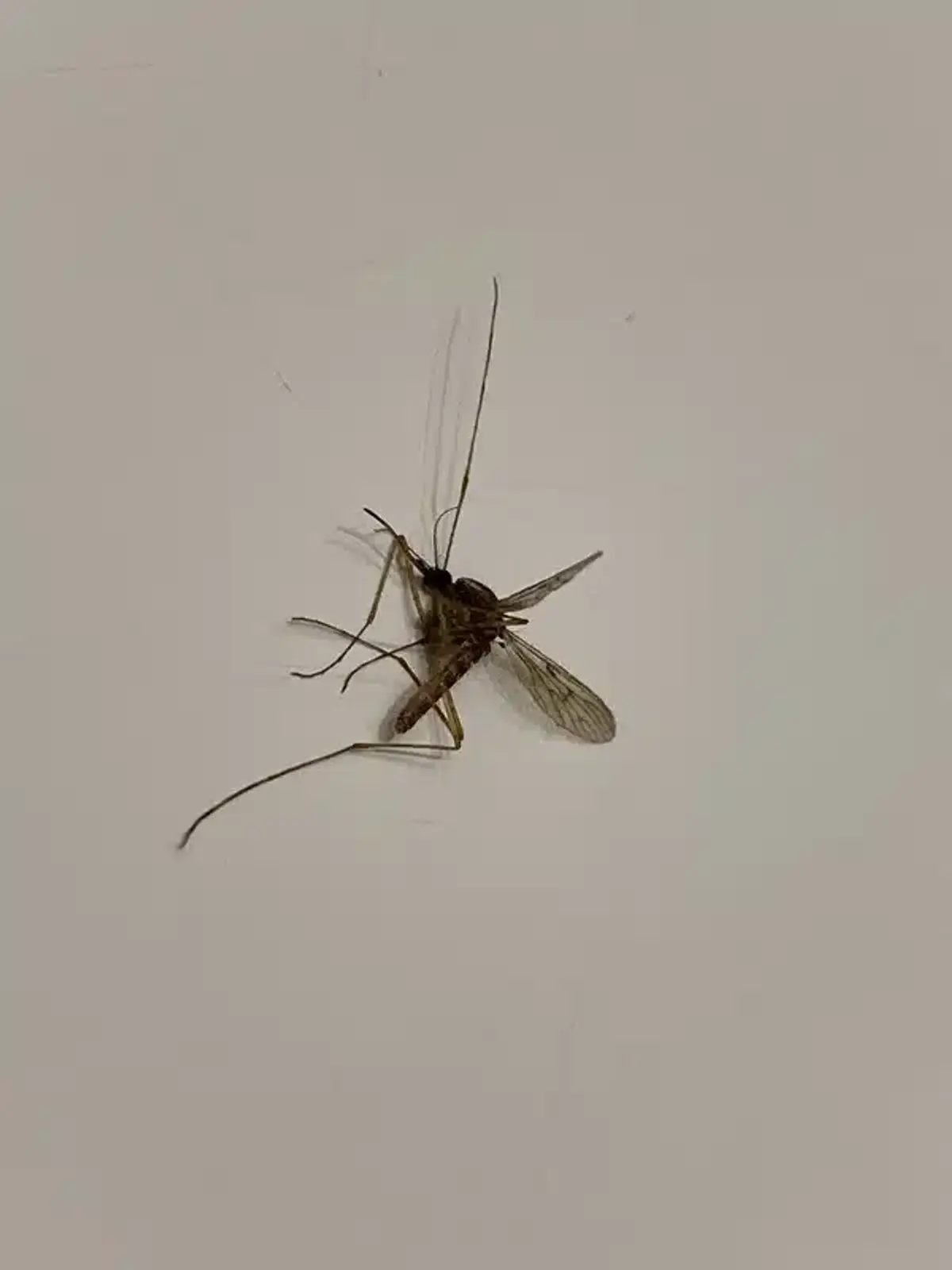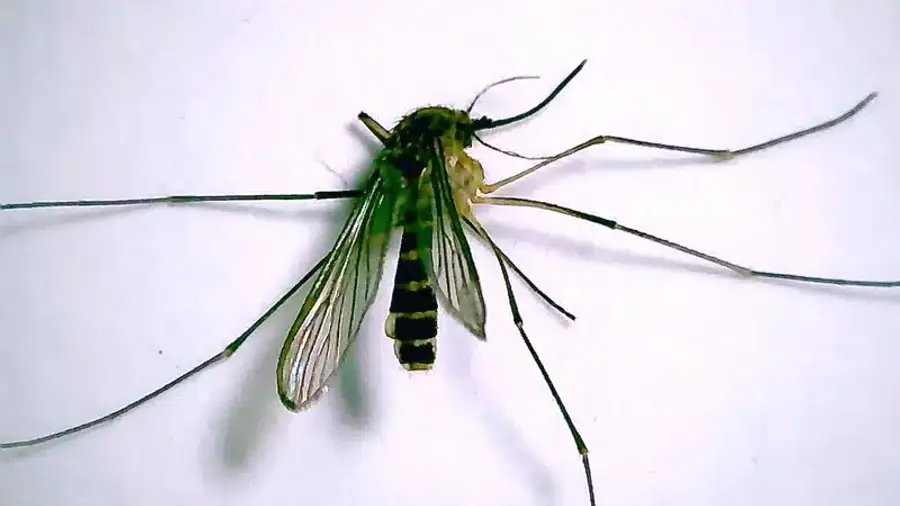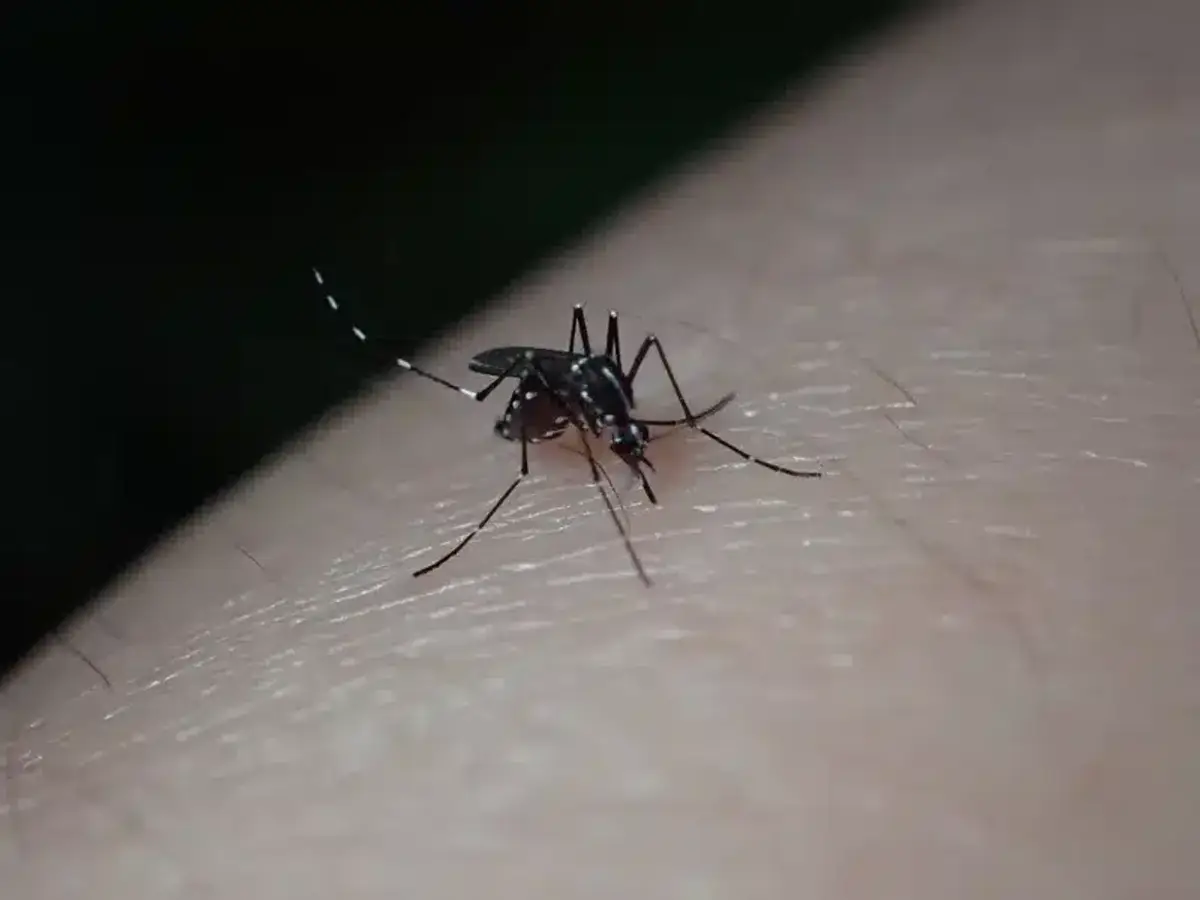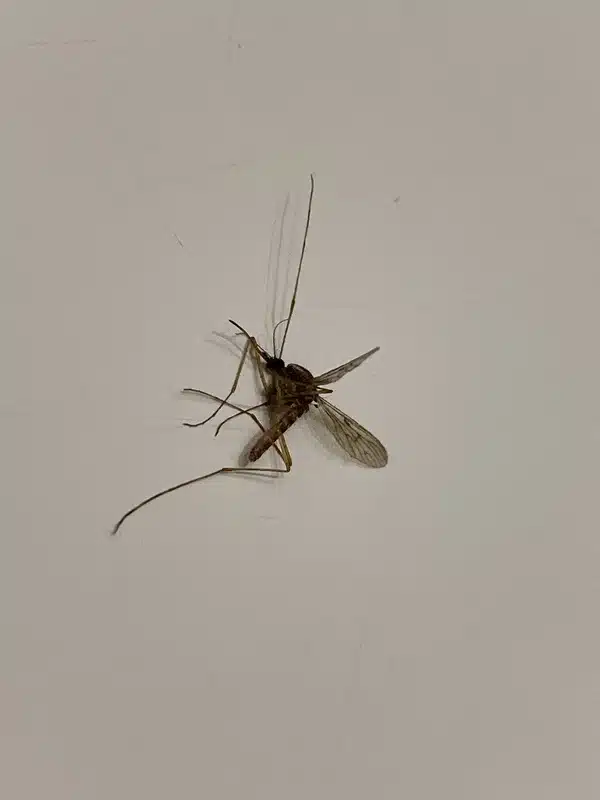Every spring and summer, I hear from homeowners who spot what they think are “giant mosquitoes” buzzing around their porch lights. After nearly a decade as a registered technician dealing with challenging pests like termites, ants, and especially mosquitoes, I can tell you that these gangly visitors are almost always crane flies. While they look intimidating and earn nicknames like “mosquito hawk,” crane flies are completely harmless creatures that get mistaken for their biting cousins.
Understanding the difference between crane flies and mosquitoes can save you unnecessary worry. While mosquitoes require serious control measures due to their biting habits and disease transmission, crane flies need no management at all. Let me walk you through the key differences so you can spot which flying insects are actually worth your concern.

What’s the Difference Between Crane Flies and Mosquitoes?
The difference between crane flies and mosquitoes becomes obvious once you know what to look for. Crane flies are much larger than mosquitoes, typically measuring 25-38 mm in body length with extremely long legs that can span up to 65 mm. In contrast, common mosquitoes in our area only reach 3-7 mm in length.
When you see what looks like a giant mosquito hovering around your lights, you’re likely observing a crane fly. These insects have a distinctive V-shaped groove on their back and wings that lack the scales you’ll find on mosquito wings. Additionally, crane flies hold their wings at about a 45-degree angle when resting, while mosquitoes typically fold theirs closer to their body.


| Crane Flies | Mosquitoes | |
|---|---|---|
| Size | 25-38mm body | 3-7mm body |
| Can Bite | No | Yes (females) |
| Disease Risk | None | High |
| Flight Pattern | Clumsy, wavering | Agile, precise |
| Control Needed | No | Yes |
Mouthparts: The Critical Difference Between Crane Flies and Mosquitoes
The most important difference between a mosquito and crane fly lies in their mouthparts. Adult crane flies don’t eat anything at all - they lack the piercing mouthparts necessary for feeding. Some species might occasionally sip nectar or dew, but they primarily survive on fat reserves from their larval stage.
Female mosquitoes, on the other hand, possess a specialized proboscis with six needle-like stylets that pierce skin to access blood vessels. This blood-feeding apparatus is what makes mosquitoes a serious pest concern. Male mosquitoes feed on nectar and plant sugars, but female mosquitoes feed on blood to develop their eggs.
What does the science say?
According to University of Arizona Extension research, adult crane flies are physiologically incapable of feeding due to their underdeveloped or absent mouthparts. This is a fundamental biological difference that separates them from all blood-feeding insects, including mosquitoes which have evolved highly specialized piercing-sucking mouthparts for obtaining blood meals.

Why Adult Crane Flies Don’t Eat
Adult crane flies don’t eat because their entire adult phase focuses on reproduction. They live for only 10-15 days, during which time they mate and lay their eggs. This short lifespan means they rely entirely on energy stored during their larval development.
Though crane flies may occasionally feed on nectar when available, most species go their entire adult lives without eating. This fundamental difference explains why crane flies pose no threat to humans - they literally cannot bite or sting.
Flight Patterns and Behavior
You can easily distinguish crane flies from mosquitoes by watching how they fly around your home. Crane flies have weak, wavering flight patterns and appear clumsy in the air. Their long legs dangle below them and help provide tactile feedback for navigation, but this makes their movement look awkward and uncontrolled.
Mosquitoes display much more agile flight capabilities. They hover precisely, maneuver quickly, and can land softly on human skin without being detected. Mosquitoes are crepuscular, meaning they’re most active during dawn and dusk when they seek blood meals.
Larval Differences and Habitat
The difference between crane flies and mosquitoes extends to their larval stage and preferred habitats. Crane fly larvae, sometimes called “leatherjackets,” live in moist soil, turf, or leaf litter where they feed on decaying organic matter. They don’t require standing water like mosquito larvae.
All mosquito larvae are aquatic and must develop in standing water. They breathe at the surface and feed on algae, bacteria, and organic particles. This is why mosquito control focuses heavily on eliminating water sources around your property.
Larvae feed on decaying organic matter in both species, but their habitats differ significantly. Understanding these breeding requirements helps explain why crane flies appear around moist areas while mosquitoes concentrate near standing water sources.
The “Mosquito Hawk” Myth
Many people call crane flies “mosquito hawks” or “mosquito eaters,” believing these insects hunt and kill mosquitoes. Unfortunately, this common nickname creates dangerous misconceptions about pest control. Crane flies eat mosquitoes is simply not true.
The mosquito hawk reputation likely stems from crane flies’ large size and their appearance during mosquito season. However, since adult crane flies don’t eat at all, they provide zero help in controlling mosquito populations. Some people also confuse crane flies with dragonflies, which do actually prey on mosquitoes.
This misconception can lead homeowners to avoid necessary mosquito control measures. When you see crane flies around your property, don’t assume they’re keeping mosquito numbers down - you still need proper professional mosquito management if biting insects are a problem.
Seasonal Appearance
Crane flies and mosquitoes have different seasonal patterns in the Mid-Atlantic region. Native crane flies typically peak in late winter and early spring, while some invasive species like Tipula oleracea have flight periods in May and again from September through October.
Mosquitoes become active once temperatures consistently exceed 50 degrees F, typically creating nuisance levels from May through October. Most types of mosquitoes reach peak activity during the warmest summer months when they can complete multiple generations.
This timing overlap in late spring and early fall explains why homeowners often confused about the flying insects around their homes. Both species may be present simultaneously, making proper identification crucial.
Mosquito Disease Transmission and Health Concerns
The health implications represent the most critical difference between mosquitoes and crane flies. Crane flies are harmless to humans - they cannot bite, sting, or transmit any diseases. These insects are often confused with dangerous pests but pose absolutely no health risks.
Mosquitoes carry serious diseases including West Nile virus, dengue fever, and malaria. Female mosquitoes require blood to survive and develop eggs, making them active disease vectors. Even in areas with lower disease risk, mosquito bites cause itchy welts and can trigger allergic reactions.
What does the science say?
The CDC reports that mosquitoes are responsible for transmitting diseases to more than 700 million people annually worldwide. These diseases include malaria (which kills over 400,000 people yearly), dengue fever, Zika virus, West Nile virus, and yellow fever. The CDC emphasizes that effective mosquito control is essential for public health protection.

Health Protection Priority
- Disease Prevention: Mosquitoes transmit life-threatening diseases like malaria, Zika, and West Nile virus
- Immediate Action: Professional mosquito control reduces populations by 90% within 24-48 hours
- Family Safety: Children and elderly are at higher risk for severe mosquito-borne illness complications
- Outdoor Enjoyment: Effective treatment allows families to safely use their yards and outdoor spaces
Diseases like malaria, Zika, and West Nile virus make mosquito control a public health priority. In my experience helping families reclaim their backyards from mosquito infestations, the health risks always outweigh the inconvenience of professional treatment.
Why Crane Flies Are Attracted to Light
Crane flies frequently appear around porch lights and indoor lighting because of their dorsal-light response. Like many nocturnal flying insects, crane flies orient their backs toward the brightest light source. This navigation system works well outdoors but causes them to circle endlessly around artificial lights.
This behavior explains why homeowners often see what looks like a giant mosquito bumping into their windows or hovering near exterior lighting. The crane flies aren’t seeking food or trying to enter your home - they’re simply following their natural navigation instincts.
Reducing exterior lighting can minimize crane fly activity around your home, though this isn’t necessary since these insects are completely harmless. The presence of crane flies attracted to light doesn’t indicate any pest problem requiring treatment.
Mosquito Control vs Crane Fly Management: Pest vs Non-Pest
Understanding the differences between these flying insects helps determine when pest control action is actually needed. Crane flies pose no threat and require no control measures. Even when present in large numbers, these insects will complete their short life cycle and disappear naturally.
Mosquitoes, however, need active management to protect your family’s health and comfort. Effective mosquito control process involves eliminating breeding sites, applying targeted treatments to resting areas, and ongoing monitoring throughout the season.
In my years of helping homeowners with mosquito problems, I’ve learned that education about harmful vs. harmless insects is crucial. Spending time and money treating crane flies wastes resources that should focus on actual threats like mosquitoes.
When to Call for Help
Contact professional pest control when you’re dealing with actual mosquito problems - frequent bites, mosquitoes entering your home, or inability to enjoy outdoor spaces. Mosquito control programs can reduce populations by over 50% within 24 hours of treatment.
For crane flies, simply wait for them to complete their natural life cycle. These insects will disappear on their own without any intervention needed.
Key Differences Summary
Spot the differences between crane flies and mosquitoes using this quick checklist:
- Size: Crane flies are much larger (25-38mm) with extremely long legs; mosquitoes are small (3-7mm)
- Mouthparts: Crane flies cannot bite; mosquitoes have piercing proboscis for blood feeding
- Flight: Crane flies wobble weakly; mosquitoes hover and maneuver precisely
- Feeding: Adult crane flies don’t eat; female mosquitoes feed on blood to survive
- Larvae: Crane fly larvae feed on decaying matter in soil; mosquito larvae develop in standing water
- Health risk: Crane flies completely harmless; mosquitoes transmit diseases
- Control needs: Crane flies require no treatment; mosquitoes need professional management
Understanding the Differences Matters
Education about flying insects helps homeowners make informed decisions about pest control. Many families waste money treating harmless crane flies while ignoring serious mosquito problems. As someone who has dealt extensively with mosquito infestations in my own family’s backyard, I understand the importance of focusing resources on real threats.
Crane flies vs mosquitoes might seem like a minor distinction, but it affects everything from your family’s comfort to your pest management budget. Knowing that crane flies are also known as mosquito hawks (incorrectly) helps you avoid falling for this common misconception.
When you can properly identify the difference between crane flies and mosquitoes, you’ll feel more confident about when to take action and when to simply wait for nature to take its course. This knowledge empowers you to protect your family effectively while avoiding unnecessary treatments.
If you’re dealing with actual mosquito problems around your home or need help identifying flying insects, don’t hesitate to reach out. Our team can help you get rid of mosquitoes effectively while providing education about harmless species like crane flies. Call us at 703-683-2000 or email us at info@bettertermite.com for a consultation.
Frequently Asked Questions
Do crane flies keep mosquitoes away?
+
No, crane flies don't keep mosquitoes away or eat them. Adult crane flies don't eat at all and cannot control mosquito populations. The "mosquito hawk" nickname is completely inaccurate and leads to dangerous misconceptions about pest control.
How harmful are crane flies?
+
Crane flies are not harmful at all. They cannot bite or sting humans, don't transmit diseases, and don't damage property. These insects are completely harmless and require no control measures.
What is the difference between a crane fly and a mosquito?
+
The main differences include size (crane flies are much larger), mouthparts (mosquitoes can bite, crane flies cannot), flight patterns (crane flies are clumsy, mosquitoes are agile), and health risks (only mosquitoes transmit diseases and bite humans).
Why are crane flies called mosquito killers?
+
Crane flies are incorrectly called mosquito killers or mosquito hawks due to their large size and appearance during mosquito season. However, this is a myth - crane flies don't eat mosquitoes or any other insects as adults.
Should I spray for crane flies?
+
No, you should never spray for crane flies. These insects are harmless, have very short lifespans, and will disappear naturally. Save your pest control budget for actual threats like mosquitoes that require professional management.
When do crane flies appear?
+
Native crane flies typically appear in late winter and early spring, while some invasive species have flights in May and September through October. Their timing often overlaps with mosquito season, leading to confusion between the species.
Can crane flies bite humans?
+
No, crane flies cannot bite humans. They lack the piercing mouthparts that mosquitoes use for blood feeding. Adult crane flies either don't eat at all or occasionally sip nectar, making them completely unable to bite or sting.
How long do crane flies live?
+
Adult crane flies live only 10-15 days. Their short lifespan focuses entirely on mating and laying eggs. This brief adult phase explains why they don't need to feed - they survive on energy reserves from their larval stage.
With five years of hands-on experience in the pest control industry, George Schulz is a registered technician with the Virginia Pest Management Association and a proud third-generation professional in a family business that's been protecting homes for over 57 years. He manages and trains a team of service pros while also leading internal research efforts—recently spearheading a deep-dive review of thousands of documents on pest control materials to hand-pick the most kid and pet friendly, most effective solutions tailored specifically for homes in the DC metro area.
